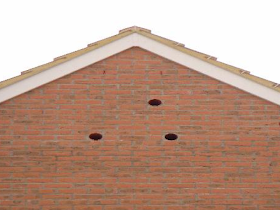 |
| Assembly of cavity panel, entrance pipe and nest box |
 |
| Exploded view |
 |
| Holes with pipes inserted |
 |
| Cavity Panels added |
 |
| Internal box, made of marine plywood |
 |
| Entrance pipes through insulation, before brickwork |
We have described here the success of internal nest boxes in Fulbourn, which seem to be greatly preferred by Swifts to external nestboxes:
In 2013, Swifts used 66 out of 139 internal nest boxes, but only 9 out of 88 external nest boxes. The internal boxes were custom made out of marine plywood, the external boxes were Schwegler 1MF's
All of the internal boxes are placed in roof spaces (attics) above the level of any living quarters. So nice and high for the Swifts and out of the way of humans. Typically, entrances are provided through a gable end.
A 4 inch core drill was used to drill a hole through the brickwork and insulation. In these houses there was no cavity, just a thick layer of insulation inside the brickwork. A 4 inch pipe provided a route from the entrance cavity panel to the nest box.
Why is Fulbourn so successful?
70 pairs of Swifts were displaced from their old nest sites, so there was a large surplus of established birds looking for somewhere to breed. This shows that, contrary to advice sometimes given, it is well worth providing replacement nest sites, even if you cannot put them close to the old nesting places.
The difference between the internal and external nest boxes is that the entrances face in different directions - maybe it was easier for these birds, desperate to find somewhere to breed, to spot the horizontally-facing entrances of the internal boxes first.
Starlings occupied many of the Schwegler 1MF's, this could have deterred the Swifts from using these boxes.
Perhaps Swifts particularly like to have a certain distance between the entrance and the nesting place, provided by the 4 inch pipe.
There was a limited amount of attraction call playing, but in this case, it was probably a minor factor.
What might one do differently
It may be relevant to ask what one might do differently, not that it is necessary to do anything differently - as it works very well.
The inside of the pipe was roughened to give the Swifts a grip. It might be easier to use a small amount of cement mortar to give a rough flat path.
The entrance hole is placed in the centre of the box. Swifts may prefer it off centre, nearer one end.
The boxes are quite large, with a floor area 400-500mm x 140mm. 300-400mm x 175mm might be better proportioned.
The pictures, left, should be self explanatory - click any one to see enlarged versions of all of them.
Acknowlegement
Thanks are due to Rob Mungovan of South Cambs District Council who was the driving force behind this project and also for the use of his pictures.
#inserts

Informative! I always follow your blog and it impress me.....
ReplyDeleteThanks,